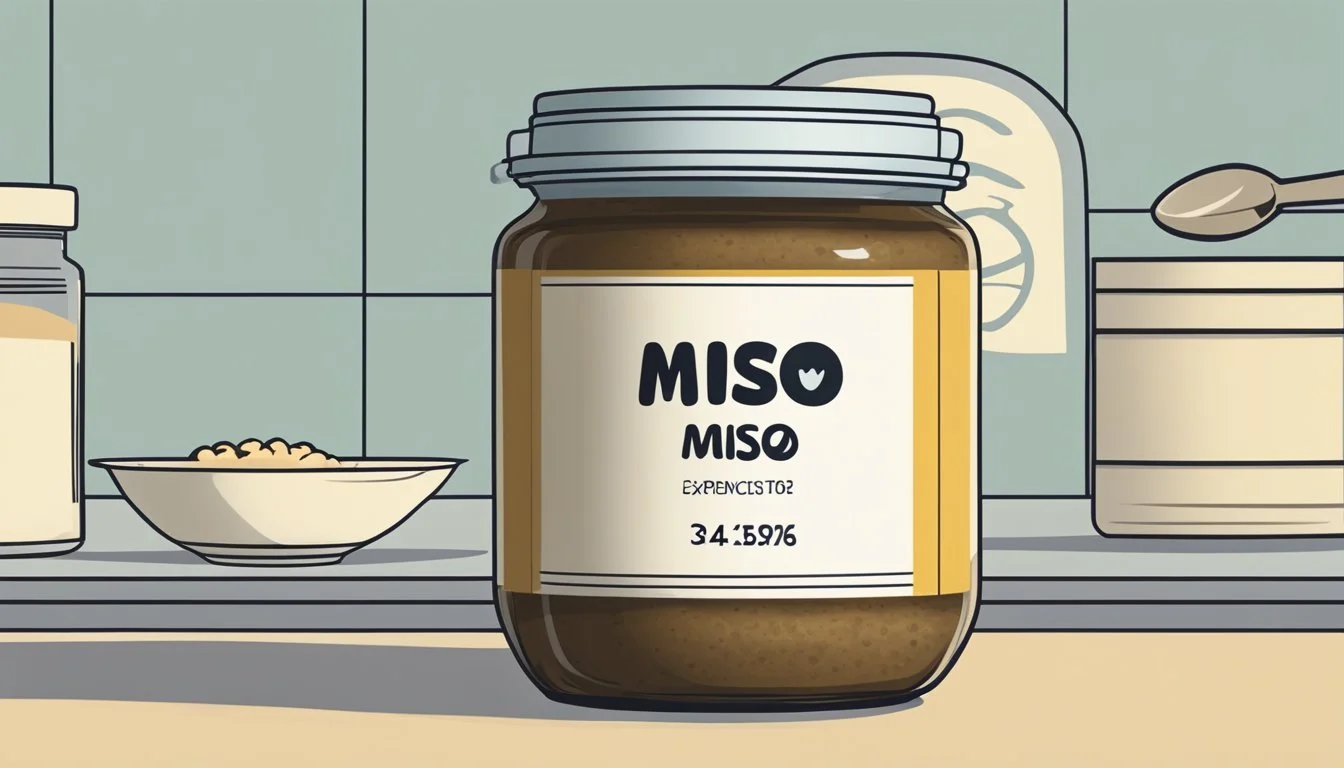Does Miso Go Bad?
Understanding the Shelf Life of This Fermented Staple
Miso, a staple in Japanese cuisine, is a fermented paste that's known for its rich umami flavor. As a fermented food, miso is created through the aging of soybeans, salt, and sometimes grains like rice or barley, under specific conditions. The process not only contributes to miso's unique taste but also to various health benefits, such as aiding in digestion and providing a source of protein.
Despite its high salt content, which acts as a natural preservative, miso can degrade in quality over time. Its long shelf life, often extending up to a year depending on the variety, allows it to be used over many months when stored properly. However, miso’s flavor, aroma, and texture can change, which sometimes leads consumers to question whether it has gone bad. Proper storage is key to maintaining the integrity of miso paste, and even though it can last a considerable amount of time, there are specific conditions that help preserve its quality.
Factors such as whether the miso is pasteurized or unpasteurized, the type of miso, and the way it is stored after opening can all affect the longevity and freshness of miso. Refrigeration is recommended to extend its shelf life, and some even freeze the paste to maintain its flavor profile for longer periods, although it doesn't necessarily freeze solid due to the salt content. Being aware of how to properly handle and store miso can ensure that it remains a flavorful and beneficial addition to a variety of dishes.
Understanding Miso
Miso is a staple in Japanese cooking, known for its umami flavor. This traditional soybean paste varies in type and offers numerous health benefits, central to its role in both cuisine and nutrition.
Types of Miso
Miso paste is chiefly made from fermented soybeans, and the length of fermentation determines its color, taste, and nutritional profile. Three primary types of miso are:
Red Miso (Aka Miso): Made with a higher percentage of soybeans, fermented for longer, and has a stronger, saltier flavor.
White Miso (Shiro Miso): Fermented for a shorter period with a higher proportion of rice to soybeans, yielding a milder, slightly sweet taste.
Yellow Miso (Shinshu Miso): A balance between red and white, made with soybeans, barley, and rice, offering a versatile flavor.
Miso can also include different grains like barley (mugimiso) or specialized types such as koji miso, which utilizes a rice culture known as koji.
Health Benefits of Miso
The health benefits of miso are manifold due to its nutritional components. Each serving is rich in:
Protein: Essential for muscle repair and maintenance.
Probiotics: The fermentation process introduces beneficial bacteria, supporting digestive health.
Consumption of miso can lead to a reduced risk of certain diseases and may alleviate menopause symptoms. It's critical to note that miso is naturally high in sodium, and while it contains healthful elements, portions should be consumed in moderation.
Miso's Role in Culinary Practices
Miso, a product of fermentation, is an indispensable seasoning in Japanese cuisine, branching out globally to enhance various recipes with its umami-rich flavor.
Traditional Miso Soup
Miso soup is a quintessential Japanese dish featuring a base of dashi—a broth made from seaweed and/or shaved fermented tuna. It often includes tofu, seaweed, and green onions as standard ingredients. The preparation of authentic miso soup involves dissolving miso paste into dashi, being careful not to boil the mixture to preserve the delicate flavors.
Basic Miso Soup Recipe:
Dashi: 4 cups
Miso paste: 3-4 tablespoons
Tofu: 1/2 cup (cubed)
Seaweed (Wakame): 1/4 cup (rehydrated)
Scallions: 2 (finely chopped)
Instructions:
Heat dashi in a pot until just before boiling.
Reduce heat and add tofu and seaweed.
Dissolve miso paste in a ladle of warm dashi, then stir mixture into the pot.
Serve immediately, garnished with scallions.
Using Miso in Diverse Recipes
Miso's versatility extends beyond soups into an array of culinary applications. It serves as a robust seasoning in salads when whisked into dressings, and it can be blended with butter to create miso butter, adding complexity to vegetables and meats. As a marinade or part of sauces, miso brings depth to dishes, and it's also used in broths to impart a savory essence. Creative adaptations like miso mayo harness its flavor in familiar condiments.
Examples of Miso Applications:
Salad Dressings: Whisk miso into a vinaigrette for an umami twist.
Marinades: Combine with ingredients like sake, mirin, and ginger to marinate proteins.
Sauces: Miso can be the base for rich, savory sauces, complementing dishes like ramen.
Miso Mayo: Mix miso with mayonnaise for a flavorful dip or sandwich spread.
Recipes utilizing miso celebrate its fermentation origins and its role as a cornerstone of Japanese culinary tradition, adapting it to enliven an extensive range of dishes with its rich, savory character.
Shelf Life and Storage
Miso's longevity is a testament to its preservation qualities, but storage methods can significantly impact its shelf life.
Determining Miso's Expiration
An unopened package of miso can typically remain edible for one year past its best-by date, but quality may diminish over time. After opening, miso should be used within 6 to 12 months for optimal flavor. Signs of spoilage include a drastic change in color or the presence of mold. The miso's type and storage conditions greatly influence its shelf life.
Proper Storage Methods
To maintain miso's integrity, it should be stored in an airtight container in the refrigerator. The cool temperature slows down the fermentation process and prevents microbial contamination. Exposure to air and fluctuating temperatures can degrade miso’s quality, so it's imperative to keep it tightly sealed.
Pantry: Not recommended for opened miso.
Room Temperature: Can store unopened miso temporarily.
Refrigeration: Ideal for extending shelf life.
Freezing Miso
While miso does not freeze solid due to its salt content, storing it in the freezer is acceptable. Freezing miso can prolong its shelf life without altering its flavor significantly if kept above 25°F (-5°C). It's practical to partition miso into smaller quantities for convenience.
Freezing: Suitable for long-term storage of miso.
Temperature: Higher than -5ºC (25ºF) to prevent freezing solid.
Identifying Spoilage in Miso
Miso is revered for its long shelf life, but like all food products, it is not immune to spoilage. This section offers guidance on recognizing signs of miso spoilage and ways to address potential contamination.
Common Signs of Spoilage
Several indicators can suggest that miso paste might no longer be suitable for consumption. Users should be attentive to the following:
Change in Color: If miso changes to a significantly darker hue or shows any form of discoloration, it may be an indication that it has begun to spoil.
Off Smell: A fresh miso paste generally has a characteristic earthy aroma. An unusual or foul smell is a clear sign that the miso should be disposed of.
Mold Growth: Any visible mold on the surface of miso, especially if it wasn't there before, should be taken as a direct sign of spoilage.
Sour Taste: While miso is naturally salty, any sour or otherwise unpleasant taste can be a symptom of the miso going bad.
Texture Changes: If the texture of the miso paste has altered significantly, becoming excessively clumpy or slimy, it could be due to spoilage.
Preventing and Addressing Contamination
To prevent spoilage, proper storage measures are essential.
Avoid Moisture and Air Exposure: Miso should be kept in an airtight container to prevent oxidation and moisture ingress, which can lead to spoilage.
Storage Conditions: Ideally, miso should be stored in a cool, dark place, and once opened, in the refrigerator.
Handling: It is vital to use clean utensils to scoop out miso paste to prevent the introduction of contaminants that can promote spoilage.
Addressing mold growth or other forms of contamination should be done with caution. While some suggest that scraping off the mold might salvage the rest of the product, it's generally safer to err on the side of caution and discard any miso showing definite signs of spoilage.
Miso's Preservation and Lifespan
Miso, a paste made from fermenting soybeans with salt and koji, possesses a natural preservation mechanism that gives it a notably long lifespan. Appropriate storage, however, is key to maintaining its quality and extending its usable life.
Lifespan of Unopened vs. Opened Miso
Unopened Miso: Miso's lifespan is considerably extended when it remains sealed due to its high salt content, which acts as a preservative. An unopened container can typically last for months, or even years, past the 'best by' date, assuming it’s stored in a cool, dark place. The fermentation process continues, often maturing the flavor.
Storage Tips for Unopened Miso:
Store in a cool, dark place.
Keep away from direct sunlight or heat sources.
Opened Miso: Once opened, miso's exposure to air and potential contaminants reduces its shelf life. Refrigeration becomes essential to prevent microbial growth and to maintain optimal flavor. Properly refrigerated, opened miso commonly remains usable for one year, although quality may gradually diminish.
Storage Tips for Opened Miso:
Refrigerate after opening.
Ensure lid is sealed tightly after each use.
Use clean utensils to prevent contamination.
Extending Miso's Usable Life
The usable life of miso can be significantly extended with proper storage techniques and handling.
Refrigeration: Maintaining a consistent temperature below 40°F (4°C) is crucial for preserving the quality of miso once opened.
Benefits:
Slows down the fermentation process.
Retains the miso's optimal flavor.
Salt Content: Given miso's inherent salt content, it acts as a natural preservative, which contributes to its longevity.
Note:
Higher salt misos tend to last longer.
Lower salt misos may have a shorter shelf life and require more vigilant storage.
Employing these storage strategies can maintain miso's quality, ensuring that it remains a flavorful and enriching addition to dishes.
Culinary Techniques with Miso
Miso, a traditional Japanese seasoning, brings complexity and depth to culinary creations through its unique texture and color. Mastery of its application can greatly enhance the dining experience.
Enhancing Flavors with Miso
Miso's Role in Flavor Profile: Chefs employ miso to boost umami, the savory taste that enriches flavor. The fermentation process of miso contributes to this desirable quality.
White Miso Paste: Known for its mild, sweet qualities, white miso is best in recipes where a subtle enhancement is desired.
Red Miso Paste: With a stronger, saltier flavor, red miso is suitable for hearty dishes that can stand up to its intensity.
Darker Miso Varieties: As miso darkens, its flavor becomes more pronounced, ideal for dishes requiring a robust presence.
Incorporating miso should be balanced to avoid overpowering dishes with its salinity—a careful measurement can achieve optimal flavor.
Incorporating Miso in Modern Cuisine
Adaptability in Global Dishes: Miso exemplifies versatility, blending seamlessly into various cuisines beyond traditional Japanese fare.
Miso Butter: By combining miso with butter, chefs create a condiment that transforms vegetables, grains, and proteins with a nutty depth.
Soups and Noodles: Miso serves as a pivotal ingredient for ramen noodles and hot pots, where it imparts its characteristic taste and texture.
Maillard Reaction: When miso is used as a marinade or glaze, it can contribute to the Maillard reaction, creating a rich, caramelized surface on the cooked food.
Availability at supermarkets allows home cooks to experiment with miso, integrating it into familiar recipes or crafting new favorites.





